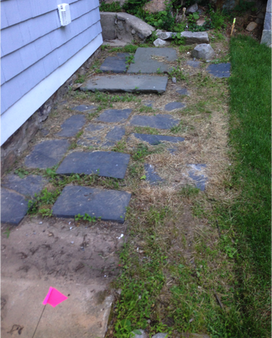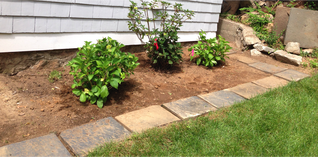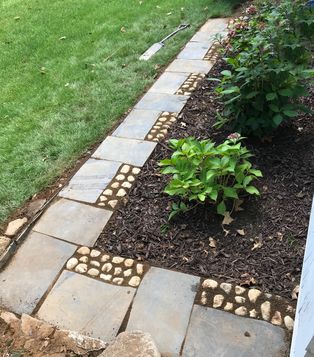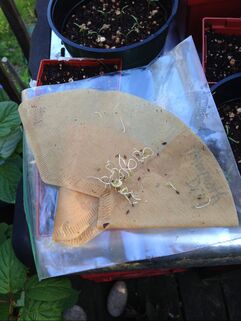|
Sometimes imagination applied to the least appreciated areas of a property can yield far better results than a client expects, and in many cases it can make the property feel bigger without spending much money.  This flagstone mishmash is one such example. The client hated weeding this area and felt it looked messy. it was a rarely visited and untended corner, so it wasn’t going to be a major focus of our efforts. The flagstone was located in a narrow strip between the house and the property line, far from any door or window -- an area that literally was out of sight, out of mind. The client —who had charged us with reusing as many existing plants and materials as possible on the property — only hoped it would at least look neat and intentional by the end of the job, and that the thankless task of weeding a casually installed area of leftover flagstones could be eliminated. A simple treatment would be to install a flagstone path along the property line and create a planting bed between the path and the house where extra existing planting material could be given a new home. We lifted some stones and did some digging underneath them to see if this idea was feasible. Nearby jutted out a large deep area of ledge, and we weren’t sure how far it extended. We were pleasantly surprised to find the soil was deep and ledge-free, which would enable us to transplant some leftover Hydrangeas from a redesigned area of the yard.  We then sorted through the flagstones and laid out a path using the stone in the best condition. While it looked perfectly acceptable for the location and purpose, it was not particularly memorable.  We opted to make a path with more character. Japanese tea garden paths often mix stone types, so we incorporated some found stone from another site. We were able to set the stone in a clean sand and stone dust mix salvaged from another path we had removed on the property. The mulch also came from the site: aged wood chips from a stump ground after an ailing tree was taken down on the property. The only purchased material was 4” steel edging installed to keep the lawn from creeping into the stone path. The location and use of the area did not merit an expensive or extensive treatment, but with imagination and modest effort, the experience of this corner of the yard changed markedly. The neighbors' view of this area from their newly created fireplace patio is of an intentional and pleasant space, and the weed-free appearance also pleases the owners of the property. Ecologically, the reuse of plants and materials leaves a much lighter footprint. When a client is newly able to enjoy and embrace more of their property than they originally believed possible, the effect is to psychologically expand the property size. Conversely, when unpleasing areas are not addressed, often the people who live with that space are subconsciously canceling or avoiding them – effectively shrinking their experience of their property size. Especially on compact properties, attending to the undervalued areas can reap big benefits for enjoyment of the space and making it feel bigger, and not necessarily at high cost.
0 Comments
 My first experience with soaking seeds was probably with something large, like sugar snap pea seeds. My second experience was probably with something like white beans, which hate to be soaked and often respond by rotting if you are not super careful. At the time, I had no idea there was a process called “priming.” Some kinds of seeds (grass seed) may be sold “primed.” This mean’s it’s been presoaked and then dried again so that it will sprout more quickly when planted in a lawn. The downside is that primed seeds do not have the shelf life of unprimed seeds. It’s a “use it or lose it” situation. When you create and care for client veggie gardens as I do, it can be a bit of a balancing act. Some veggies need to stay moist to germinate, a challenge if nobody is at the house to water. If I’m also taking care of some landscape needs at the house down the road, it’s no big deal to check in on the carrots-to-be, for example. When I'm not able to be at the garden often, pre-sprouting helps. Priming and warming those pepper and tomato seeds can also speed up plant development by a few days. When plants are tricky to start from seed in the garden, starting seeds indoors allows me to control and optimize the growing conditions. This year, I have a client who wants dill in her doorstep herb container garden. Dill, you may know, is not a fan of being transplanted. It often bolts not long after transplanting, so I can see some succession plantings on the horizon. I decided to experiment with priming dill seeds so I could plant some seedlings in the doorstep pot, while starting some seeds that will come out from backstage when the first batch starts to get tired out and go to seed. Here’s what I did:
Not all seeds respond equally well to being soaked. Arugula seeds, for example, get a mucilaginous coating and clump together. White beans are easy to over-soak, resulting in rotten beans. Some seeds need heat to germinate well (tomatoes, eggplant, peppers); others refuse to germinate with too much heat (lettuce!). It helps to look up optimal germination temperatures for the seeds you're starting. As to heat: If it's not a seed that will sprout easily at room temperature, then a heat source is needed. Very few refrigerator tops are as hot as those our grandparents' appliances used to start seeds, but presoaked seeds in moist coffee filters tucked into plastic bags, wrapped in a towel, and placed against a heating pad will move pepper and tomato seeds along nicely, using less heat than would mats to heat numerous trays. Once the seeds start to show roots, they can be transplanted into cells, trays or pots. (Oh, by the way: Not all heating mats are well quality controlled, and I have a scorched wooden table top to prove it!) Does seed starting still seem too daunting? My advice is simple: Just. Do. It. Seed starting is thrilling. I like to bring a sense of adventure to working with seeds — trying something I have never even tasted, experimenting with pushing seed sprouting to occur faster, or dipping into methods somebody else has tried and reported on. Early on, when I too was daunted, I finally asked myself, "Why do I want perfection in starting seeds? A $2.75 packet of seeds may not sprout? Can't I live with that?" (Oh, and the seeds did sprout, by the way...) If you are curious to know more about seed priming as it is done professionally, this article gives a glimpse of how it might work if you had thousands of seeds to do and not just a few out of a packet: https://www.thoughtco.com/seed-priming-speeding-up-the-germination-process-419193  Photo by Alek Kalinowski on Unsplash Photo by Alek Kalinowski on Unsplash Intrusive sounds on a landscape design project at times threaten to get in the way of the reason many of us make gardens, throwing cold water on the hope that they can comfort, heal, and create tranquility. Sometimes the sound in the garden is not one of birds, wind in the trees or spring peepers. Instead, a walk through the green space is accompanied by the cacophony of downshifting trucks, fast traveling vehicles, sirens or train horns. What to do? First, be clear what plans can and cannot do. In the best of circumstances, often it is very difficult to mitigate sound appreciably using vegetation, unless you have a lot of space and a lot of plants and money. Visual screening is psychologically soothing, but some sounds are too intrusive to be impacted much by a few evergreens. If looking at the inside to get rid of sound on the outside, It is also hard to retrofit sound proofing into e.g.the walls of a bedroom. The area where the sound is a problem may be a key to the strategy to try to offset it. Sound is amplified when it bounces off buildings and hard surfaces, so that sound can be actually louder right beside the hard surface (house?) than say 20 feet closer to the sound/away from the house due to this characteristic. Vines on a building or wall help reduce reflection and muffle the sound a bit. Don't count on a row or two of shrubs or evergreens, however. Because sound travels like water, it can and will find a way through anything that is not super tight, or just go over the top of a fence. The source of the sound, pitch (high or low) and elevation of the sound are useful to observe. (second floor of the house being demo'd? street level?) In the realm of relatively simple solutions, they may go beyond the garden and into the house. Moving the bedroom or sitting room to the opposite side of the house (whatever is key to where the owner spends time( location may turn out to be the least expensive and fastest way to start enjoying life again, since the lived- in areas may receive less noise. After doing so, changes to the landscaping to make wonderful view from that newly repurposed room wonderful could make use of the house itself as a sound barrier. There are also indoor and outdoor water features, and that might be a distracting and pleasant counter to the exterior ruckus. Keeping the rooms as they are and trying a planted screening between the sound and the observer will have other positive psychological effects (people who have a tree view out the window in hospitals got well faster in one study). But out of sight does not mean that sound will not travel. Think of sound as moving similarly to water. It will find a way through most anything! One other factor in sound mitigation is that higher-pitched sounds occur to the human ear as louder (more intrusive) than lower pitched sounds. It can be useful to listen to annoying sounds yourself to observe which sounds are most bothersome, considering whether pitch is a factor. Lower pitched sounds travel farther but are less intrusive, it is said. (This may be in the ear of the beholder, especially if a medical condition impacts how the sound is heard.) In the example of train horn noise, I discovered that the Metro North train horns are required by regulation to blast between 96 and 110 dBa. Much discussion focused on whether the horns were "too loud," and the railroad countered that they were "within legal limits". None of this helped the family who recoiled in intense pain when a train horn was blasted not far from their home. After intensive research, I learned that within the past few years, the railroad had actually changed the tones involved in the horn blast (each railroad's horns have a distinctive set of notes), adding one higher pitched note. It was when the pitch got higher that residents who had lived along the railway started complaining about the noise, thinking it was louder. People do hear higher pitched sounds as louder than equally loud lower pitched sounds. If sound mitigation is a prominent consideration in a landscape, remember that a lot of money can be poured into a poorly understood problem, and sound is frequently incompletely understood by designers. There are companies that will first analyze the characteristics of the sound, and then recommend an array of (their) solutions that will best address them. Few designers are accustomed to using them, but those who do are likely to find the shortest path to a satisfactory solution to an intransigent, intrusive problem. Not doing so might take a longer, more meandering route through a series of not-quite-satisfactory attempted solutions. In the end, starting the process with the mist intransigent problem and consulting with a sound engineer or specialist may save time and money in the long run and point the way to a technical solution that can be gracefully integrated into the rest of the landscape design. Have you ever considered using a wildlife educator to help clients who have wildlife fears?2/8/2019 A couple of years ago I crossed paths with a retired expert in wildlife biology while both of us were trying to help a woman who had a group of (gentle but scary to her) black snakes living on her property, including one very pregnant one. We met at her house for tea and discussed this issue and many other things. While I had met a number of wildlife management specialists who remove, kill, or deter wildlife on residential properties, i was surprised to notice how powerful his approach to wildlife education was. He was both an amazing resource when it came to in-depth knowledge about many kinds of wildlife, and a person whose passion for wild creatures equalled his patience and kindness toward humans who did not understand them. He and I combined efforts and managed to get the very pregnant snake removed for research purposes (I found the research project, he bagged the snakes in a pillowcase for researcher pickup). As it happened, while in research, the snake gave birth to the 50 babies which were subsequently relocated back in the same habitat area but not on her property. I learned that snakes have their winter strategies developed in advance of cold weather, so when approaching the time of hibernation, it is risky to translocate them out of their normal "haunt", as they are likely to die due to not being able to locate and access their traditional hibernating spot or find a new one.
I observed how his quietly shared information calmed homeowners who were driven by extreme fear or discomfort to want to get rid of an animal or destroy its home, and was gratified when some -- not all, but some -- could begin to appreciate and enjoy the creatures that shared the outdoors with them. Wildlife education may be a winning strategy to employ, and one that may open up an enriched experience and new possibilities for the client's landscape. Designing the animals out of the equation may be a less interesting solution, just as it is probably ecologically out of touch. If we can help people treasure the planet and love their piece of it, our job changes, allowing us to move away from a reactive focus on editing out what is natural and toward enriching our clients' experience of the natural and of the creatures that share the land they live on. |
Categories
All
Our Blog
The Root of the Matter is a blog created by Bespoke Gardening owner Christine Reid to share observations and in-depth insights from a seasoned professional gardener. Edible gardening, perennial gardens, and shrubs and trees — as well as the environments in which they live and the ways we care for them — are all areas of interest. Archives |
Copyright © 2022 Bespoke Gardening, LLC. All Rights Reserved




 RSS Feed
RSS Feed